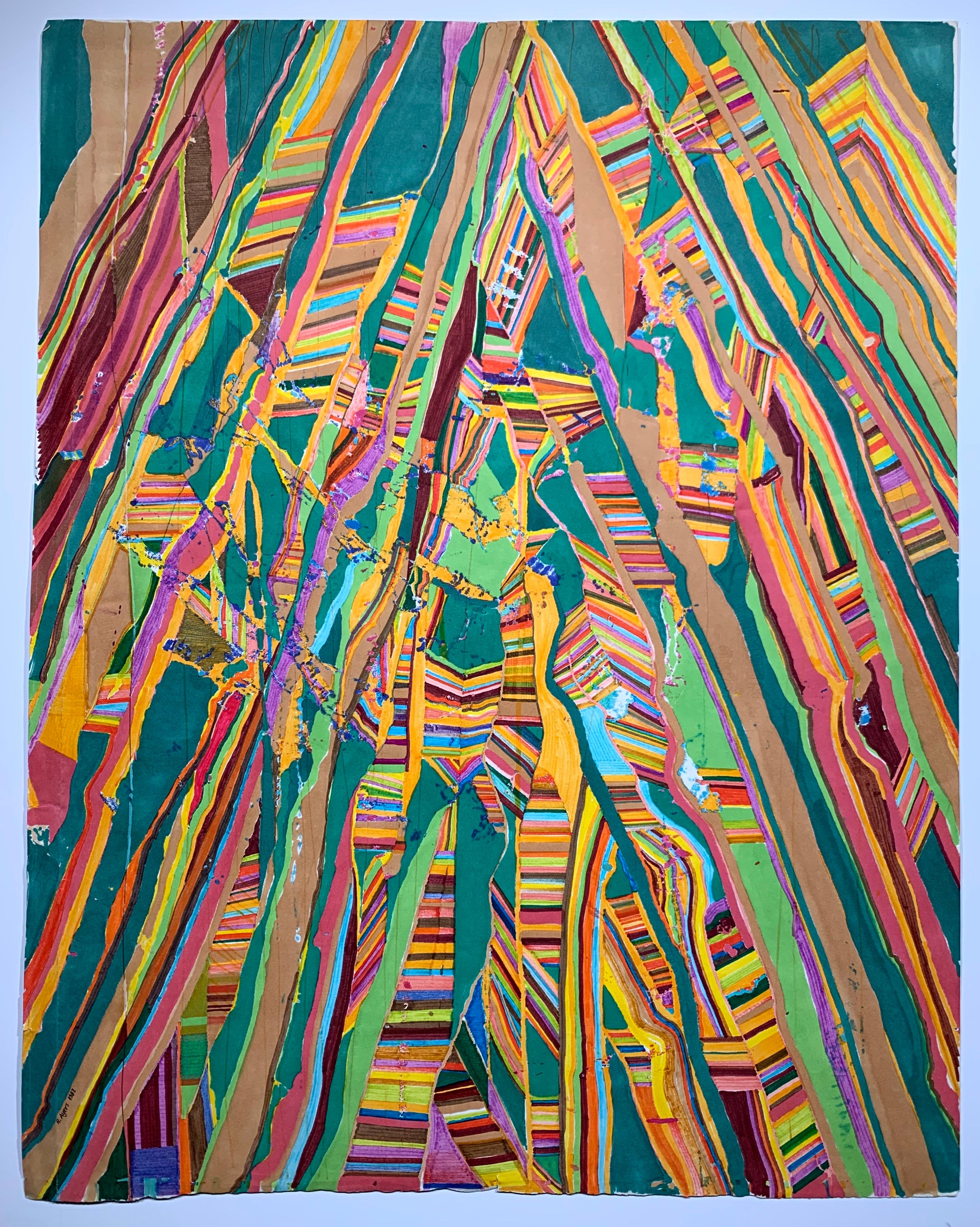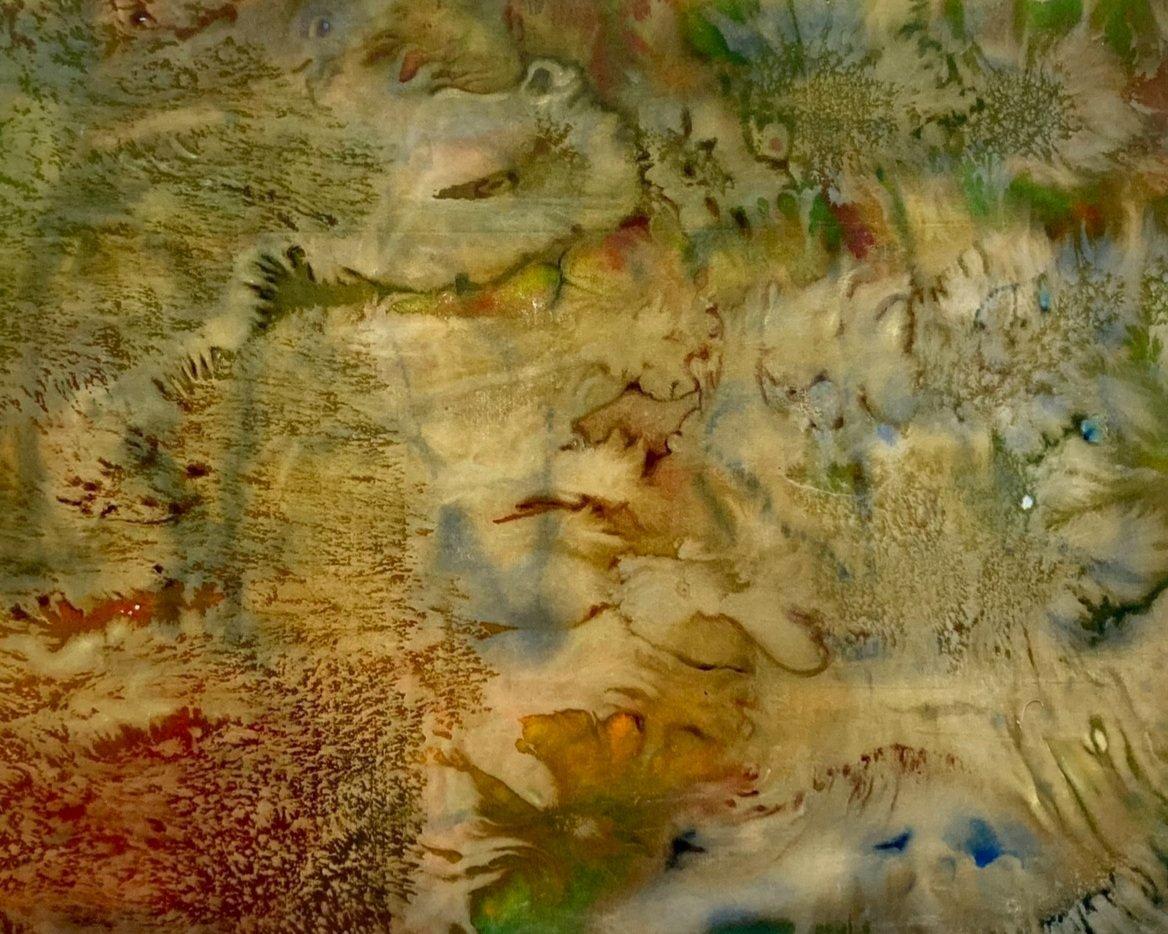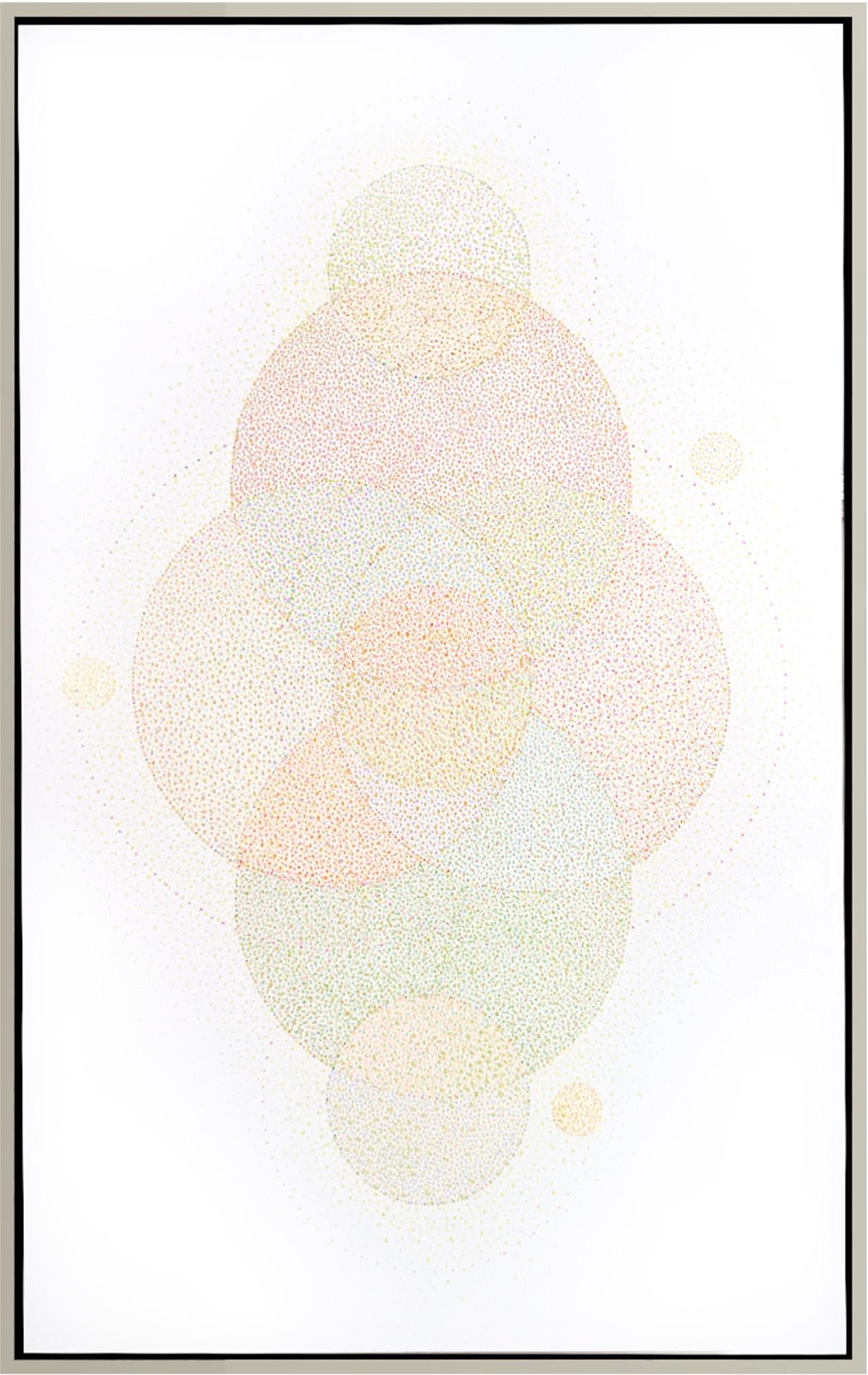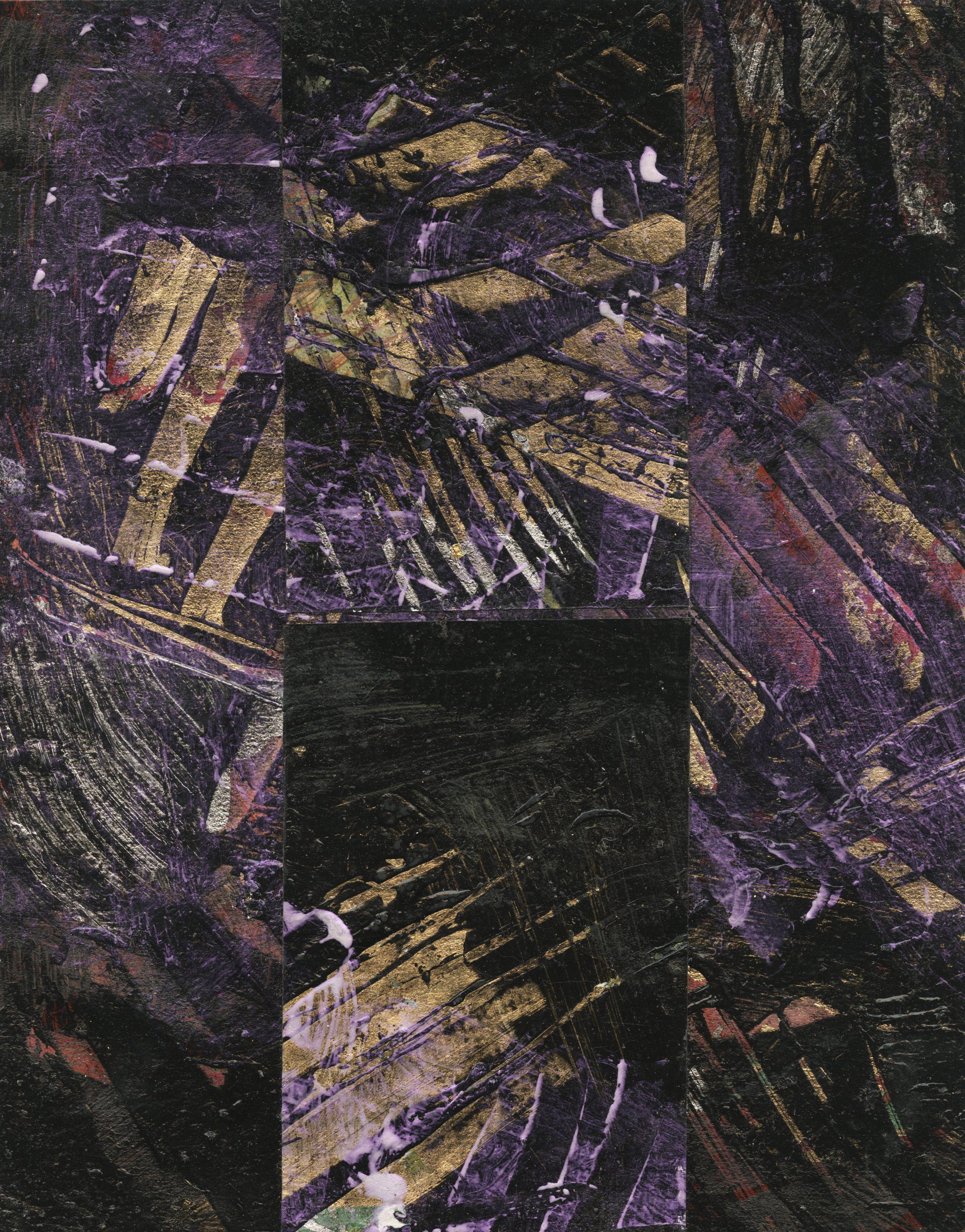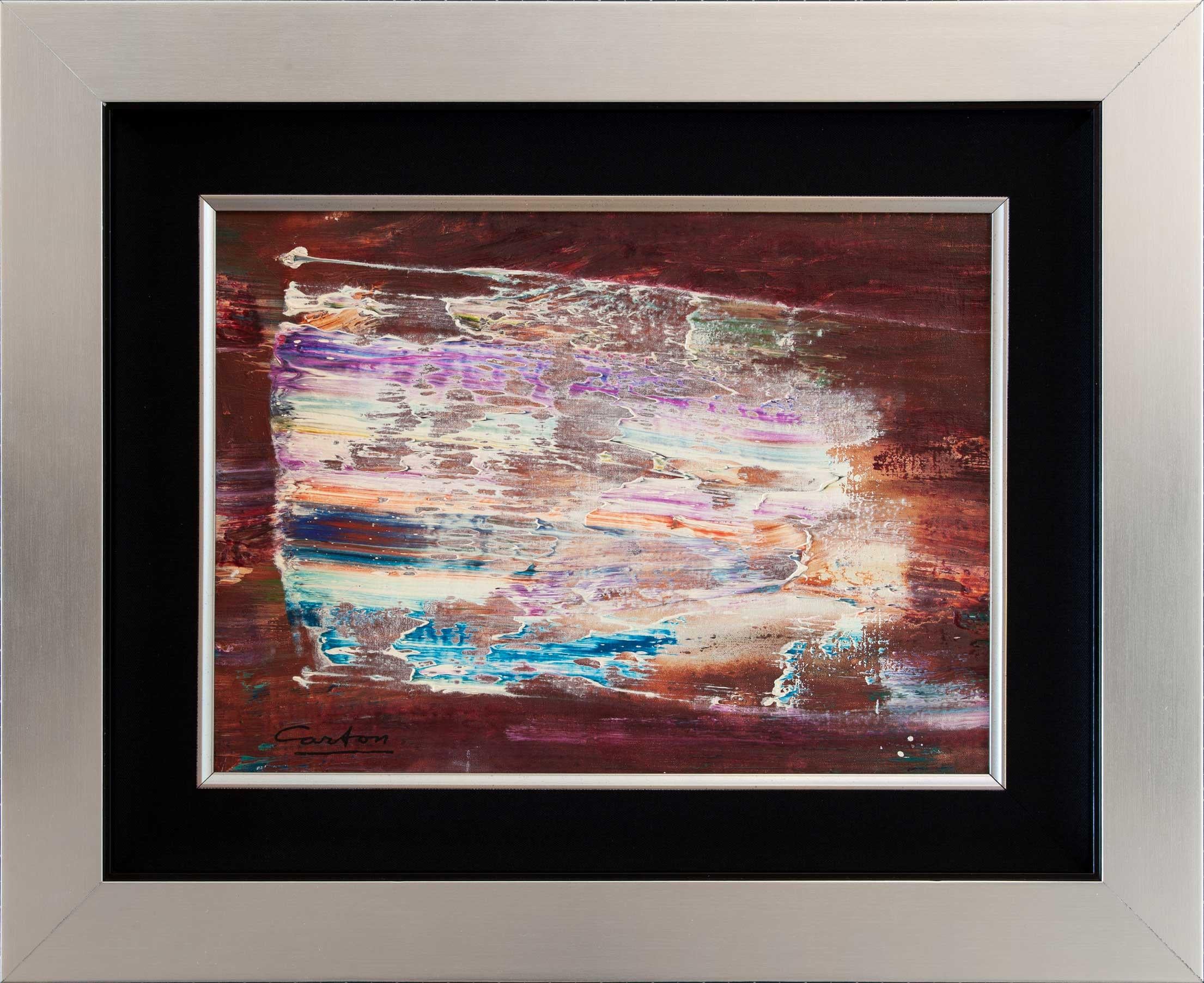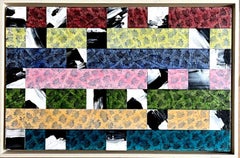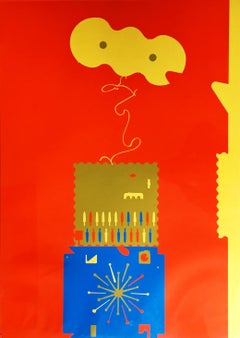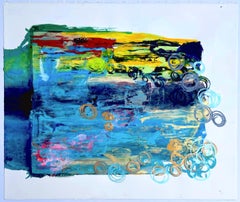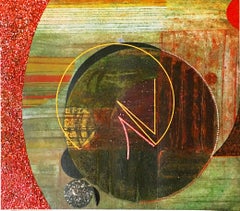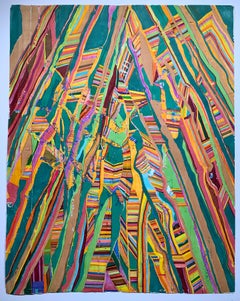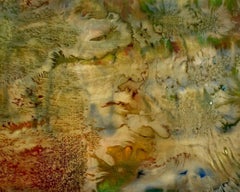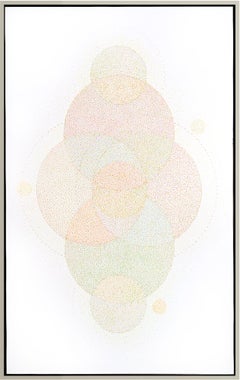Want more images or videos?
Request additional images or videos from the seller
1 of 11
Pat AdamsExtended Alike1969
1969
$7,900
£6,170.53
€6,995.03
CA$11,325.54
A$12,423.49
CHF 6,500.16
MX$147,864.30
NOK 82,101.04
SEK 77,012.24
DKK 52,242.79
About the Item
Pat Adams
Extended Alike, 1969
Gouache on Paper Mounted to Canvas (Zabriskie Gallery 25th Anniversary & Contemporary Arts Center, Ohio Exhibition Labels)
Signed 'Pat Adams 12.69' upper left front
In vintage period frame
This unique, hand signed gouache on paper, mounted to canvas by renowned artist and longtime member of the Bennington College art department and National Academician Pat Adams, bears labels verso from the following exhibitions:
'Pat Adams Paintings', The Contemporary Arts Center, Cincinnati Ohio, Dec. 7-Jan. 20th.
Adams at Zabriskie '(25th Anniversary Exhibition) Zabriskie Gallery, New York, NY, Dec. 5, 1978-Jan. 6, 1979, Cat. no. 41 and'
Zabriskie Gallery, New York, Jan. 6-Jan 24, 1970
Measurements:
Framed:
19 1/2" H x 13 1/4" W
Artwork:
18" H x 11 1/2" W;
Excellent condition, held in a vintage frame
PAT ADAMS BIOGRAPHY:
Pat Adams Biography:
Pat Adams (American, b. 1928) was raised in Stockton, California, and began painting at the age of ten. She studied painting at UC Berkeley from 1945–49, where she first encountered the ideas of Hans Hofmann as she studied under his former students—Worth Ryder and Margaret Peterson O’Hagan, who had arranged for Hofmann’s migration to the States in 1932, among them. During her summers at Berkeley she pursued programs at the California College of Arts and Crafts (1945), the College of the Pacific (1946), and the Art Institute of Chicago (1948). In 1950, following her graduation from Berkeley the previous year, she attended a summer session at Brooklyn Museum Art School, remaining in the city after its completion. She received her first solo exhibition in 1954 at the Korman Gallery—later to be renamed the Zabriskie Gallery, which would continue to represent her through 2018. Her work was greatly motivated by her international travel during the 1950s: in Italy in 1951, after her first husband, painter and printmaker Vincent Longo was awarded a Fulbright scholarship, and in France in 1956, after she received her own Fulbright scholarship.
In the fall of 1964 she was invited by professor Paul Feeley to teach at Bennington college, where she joined the social circle of the famous “Green Mountain Boys,” including Kenneth Noland and Jules Olitski. In 1972 she married fellow Bennington professor R. Arnold Ricks, and they set off with her two sons on a four month journey through Egypt, Iran, Turkey, and all of Europe, which impacted her work significantly. She continued teaching at Bennington through 1993.
Her lengthy career has also included many teaching appointments at Yale, as both a visiting professor and artist, as well as the Rhode Island School of Design, among numerous other institutions across the country. She has received notable awards from the National Endowment for the Arts, the Academy of Arts and Letters, the National Academy of Design, and the College Art Association. In 1995 she was awarded the Vermont Governor’s Award for Excellence in the Arts. Her work has been the subject of over fifty solo exhibitions. She lives in Bennington, Vermont.
-Courtesy of Alexandre Gallery
- Creator:Pat Adams (1928, American)
- Creation Year:1969
- Dimensions:Height: 19.25 in (48.9 cm)Width: 13.25 in (33.66 cm)Depth: 0.5 in (1.27 cm)
- Medium:
- Movement & Style:
- Period:
- Condition:Excellent condition, held in a vintage frame.
- Gallery Location:New York, NY
- Reference Number:1stDibs: LU1745212458462
About the Seller
5.0
Platinum Seller
Premium sellers with a 4.7+ rating and 24-hour response times
Established in 2007
1stDibs seller since 2022
462 sales on 1stDibs
Typical response time: 2 hours
- ShippingRetrieving quote...Shipping from: New York, NY
- Return Policy
More From This Seller
View AllFace Value
By Richard Kalina
Located in New York, NY
Richard Kalina
Face Value, 1992
Collage and mixed media (flasche) and acrylic on laid paper painted on canvas
Signed on the verso; also bears Max Protech Gallery Label, Unique
Frame included
Hand signed, dated and titled on the verso with original label from the legendary Max Protech Gallery, as well as Christie's NYC labels. A dazzling mixed media painting that looks so much better in person.
Provenance
Max Protech Gallery
Christie's Inc (see labels)
Measurements:
Frame:
15.5 x 23.5 x 1 inch
Artwork:
15 x 23 inches
About Richard Kalina:
Richard Kalina was born in 1946 and studied at the University of Pennsylvania. He began exhibiting in 1969 and has regularly shown his work in museums and galleries, both nationally and internationally. ... Richard Kalina is Professor of Art at Fordham University in New York, where he teaches studio art and art history. This is a gorgeous work that would look beautiful in any home or office.
His works are included in museum collections such as the Arkansas Art Center, Grey Art Gallery, Guild Hall Museum, Fogg Art Museum, Indianapolis Museum of Art, Milwaukee Art...
Category
1990s Abstract Abstract Paintings
Materials
Canvas, Mixed Media, Acrylic, Laid Paper, Vinyl
Untitled
By Harold Town
Located in New York, NY
Harold Town
Untitled, 1973
Silkscreen and Lithograph. Pencil Signed. Dated. Numbered.
Hand signed, dated and numbered by the artist on the front
39 1/4 × 27 1/2 inches
Unframed
Pencil signed and numbered from the limited edition of 55. De-accessioned from the Sears, Robuck & Co. art collection
Harold Town (1924-1990) has been dubbed the "Picasso of Canada" for his ever-changing aesthetic and perennial creativity, and he exhibited widely throughout Canada. He is best known as a founding member of the Painters Eleven, having coined the term for this artistic group himself. The name refers to the eleven Abstract Expressionist artists who banded together in Toronto between 1953 and 1960: Tom Hodgson, Jack Bush, William Ronald, Alexandra Luke, Oscar Cahén, Jock MacDonald, Ray Mead...
Category
1970s Abstract Abstract Prints
Materials
Lithograph, Screen
Untitled Abstraction
Located in New York, NY
Leslie B. Weissman
Untitled abstraction, 2016
Acrylic and mixed media painting on paper
15 × 18 inches
Pencil signed and dated by the artist on the lower left front
Unframed
Biography:
Leslie B. Weissman (b. 1966, NYC)
Education:
Hobart and William Smith Colleges BA 1988 Art and Economics
New York University / Tisch MPS 1991
Recent and Upcoming Exhibitions:
PFLAG Pride In Bloom Exhibit and benefit Auction October 2020
Blue Door Gallery - Yonkers, NY Group Show, Global Expressions September 12, to October 24, 2020
Blue Door Gallery - Yonkers, NY Group Show, Summer Blues July 24, to August 29, 2020
Blue Door Gallery - Yonkers,, NY Group Show, Kinda Blue October-November 2018
Riverfront Art Gallery - Yonkers,, NY Group Show, Womantide March-April 2019
Blue Door Gallery - Yonkers,, NY Group Show, Kinda Blue October-November 2018
Morgan Stanley Corporate Headquarters - Purchase, NY September-October 2018
The Art Closet Gallery March 2018 Selected Works
Artist in Residence Chappaqua Performing Arts Center 2018 New Castle Board Inauguration conducted by President Bill Clinton
Katonah Museum AA at NWHC September 2017-March 2018
Left Fields Gallery SAN LUIS OBISPO, CA - 12/18-1/17/16 FORM IS NOT DIFFERENT FROM EMPTINESS -
Curated by Ryan Schneider...
Category
2010s Abstract Abstract Paintings
Materials
Mixed Media, Acrylic
Free More, original Zabriskie Gallery & Reader's Digest Collection labels signed
By Pat Adams
Located in New York, NY
Pat Adams
Free More, 1989
Acrylic and encaustic painting with varnish on paper laid down on canvas
Hand signed and dated on the upper left front
Original artist's frame included
This...
Category
1980s Abstract Abstract Paintings
Materials
Mixed Media, Graphite, Pencil, Acrylic, Encaustic, Varnish
Thou Shalt Not Make Graven Images (The Second Commandment), Lithograph Signed/N
Located in New York, NY
Joseph Nechvatal
Thou Shalt Not Make Graven Images (The Second Commandment), 1987
3 Color lithograph on Arches paper with deckled edges
Signed and numbered from the limited edition of 84 on the front
24 × 18 inches
Unframed
This three color lithograph on Arches paper with deckled edges is pencil signed, dated and numbered from the limited edition of 84. This classic Nechvatal print was created as part of the 1987 portfolio "The Ten Commandments", in which ten top Jewish American artists were each invited to choose an Old Testament commandment to interpret in contemporary lithographic form. The "Chosen" artists were, in order of Commandment: Kenny Scharf, Joseph Nechvatal, Gretchen Bender...
Category
1980s Abstract Abstract Prints
Materials
Lithograph
Giotto, Silkscreen with Watercolor and Acrylic on paper, HandSigned 2/3, Framed
Located in New York, NY
Robert Petersen
Giotto, 1989
Mixed Media: Silkscreen with Watercolor and Acrylic on paper
Hand signed, numbered and dated on front A.P 2/3
(Unique variant - each example unique with ...
Category
1980s Abstract Mixed Media
Materials
Screen, Watercolor, Acrylic, Mixed Media
You May Also Like
Untitled
By Roland Ayers
Located in Wilton Manors, FL
Roland Ayers (1932-2017). Untitled, 1983. Ink on paper, measures 17 x 23 inches. Unframed and unmounted. Signed and dated lower left. Ayers holds the distinction of having participated in the first important survey of African-Americans, Contemporary Black Artists in America, a 1971 show at The Whitney.
Biography:
Artist and art educator, Roland Ayers was born on July 2, 1932, the only child of Alice and Lorenzo Ayers, and grew up in the Germantown district of Philadelphia. Ayers served in the US Army (stationed in Germany) before studying at the Philadelphia College of Art (currently University of the Arts). He graduated with a BFA in Art Education, 1954. He traveled Europe 1966-67, spending time in Amsterdam and Greece in particular. During this period, he drifted away from painting to focus on linear figurative drawings of a surreal nature. His return home inaugurated the artist’s most prolific and inspired period (1968-1975). Shorty before his second major trip abroad in 1971-72 to West Africa, Ayers began to focus on African themes, and African American figures populated his work almost exclusively.
In spite of Ayers’ travel and exploration of the world, he gravitated back to his beloved Germantown, a place he endowed with mythological qualities in his work and literature. His auto-biographical writing focuses on the importance of place during his childhood. Ayers’ journals meticulously document the ethnic and cultural make-up of Germantown, and tell a compelling story of class marginalization that brought together poor families despite racial differences. The distinctive look and design of Germantown inform Ayers’ visual vocabulary. It is a setting with distinctive Gothic Revival architecture and haunting natural beauty. These characteristics are translated and recur in the artist’s imagery.
During his childhood, one of the only books in the Ayers household was an illustrated Bible. The images within had a profound effect on the themes and subjects that would appear in his adult work. Figures in an Ayers’ drawing often seem trapped in a narrative of loss and redemption. Powerful women loom large in the drawings: they suggest the female role models his journals record in early life. The drawings can sometimes convey a strong sense of conflict, and at other times, harmony. Nature and architecture seem to have an antagonistic relationship that is, ironically, symbiotic.
A critical turning point in the artist’s career came in 1971 when he was included in the extremely controversial Whitney Museum show, Contemporary Black Artists in America. The exhibition gave Ayers an international audience and served as a calling card for introductions he would soon make in Europe.
Ayers is a particularly compelling figure in a period when black artists struggled with the idea of authenticity. A questioned often asked was “Is your work too black, or not black enough?” Abstractionists were considered by some peers to be sell-outs, frauds or worse. Figurative* work was accused of being either sentimental or politically radical depending on the critical source. Ayers made the choice early on to be a figurative artist, but considered his work devoid of political content.
Organizations such as Chicago’ s Afri-Cobra in the late 1960‘s asserted that the only true black art of any relevance must depict the black man and woman...
Category
1980s Abstract Abstract Paintings
Materials
Paper, Ink
$960 Sale Price
20% Off
Untitled
Located in San Francisco, CA
This artwork "Untitled" is an oil painting on canvas by noted American artist Ruth Wall, 1917-2009. It is signed in the back by the artist. The canvas size is 10.15 x 20 inches, framed size is 13.85 x 22.75. It is custom framed in a wooden gold frame. The painting is in excellent condition, the frame has some scratches and will be replaced if buyer wish, by a similar (not exactly the same) gold frame when is sold. It will be done at no extra cost. This will bring the over all condition to excellent.
About the artist:
Ruth A. Wall was born in Wyoming on September 10, 1917 but moved to a homestead on an Indian reservation in Uintah, Utah in 1919. After graduating from high school at age 16 she left home to attend college, graduating at age 20 and began teaching high school at age 21.
She moved to Los Angeles where she became an Army materials inspector during WWII. She moved to Northern California and became a pilot, but entered the service as a WAC. Here she trained as a physical therapist and became an officer. She remained in the service until 1949.
In 1950 she entered the California School of Fine Arts in San Francisco, studying there until leaving for Paris in 1952 where she moved into the Academie Frochot. Returning to the CSFA in 1955 she worked as an artist until she had to take a job to make a living in 1957. Most of her work in printmaking was done in 1952, before leaving for Paris. They are, for the most part, gestural, Abstract Expressionist lithographs, done on the press at the CSFA at night after everyone had gone home. Her teachers were James Budd Dixon, Robert McChesney and, after 1955, Nate Oliviera and fellow students included James Kelly...
Category
Mid-20th Century Abstract Abstract Paintings
Materials
Oil
Untitled
Located in Vancouver, CA
Jesse Ross's paintings explore the complexities of identity and transformation, blending his mixed settler and Stó:lō Nation heritage with contemporary artistic expression. He uses f...
Category
2010s Abstract Abstract Paintings
Materials
Oil, Acrylic
$3,200 Sale Price
20% Off
L-22
Located in Santa Fe, NM
Painting has always been a part of my life. Over the course of many years I explored various styles of painting. I found that the more I let go and gave into simply the act of pain...
Category
2010s Abstract Abstract Paintings
Materials
Canvas, Oil
$5,600
Untitled
By Peter Marks
Located in Fairlawn, OH
Untitled
Acrylic and gold leaf collage on canvas, 2005
Unsigned
Provenance: Estate of the Artist
Condition: Excellent
Image size: 10 13/16 x 8 5/8 inches
Support Sheet size: 17 x 14 ...
Category
Early 2000s Abstract Abstract Paintings
Materials
Acrylic
Untitled
By Norman Carton
Located in Columbia, MO
Norman Carton
Norman Carton (Russian American, 1908–1980), a vibrant force in Abstract Expressionism, was known for his dynamic use of color and expressive, gestural brushwork. Born...
Category
20th Century Abstract Abstract Paintings
Materials
Canvas, Oil
$6,750
More Ways To Browse
Vintage Pat
Vintage Painting Of European Cities
H W B And Sons
Zabriskie Gallery
Berkeley Painting
B Adams
Margaret Peterson
Self Portrait Abstract
Drip Paint Art
Edinburgh Scotland Art
Elisabeth Hahn
Mixed Media Modern Green
Mystic Painting
Pina Bausch
Howard Gray Painting
Splatter Painting
Watercolor Diptych
1960s Abstract Painting Framed
